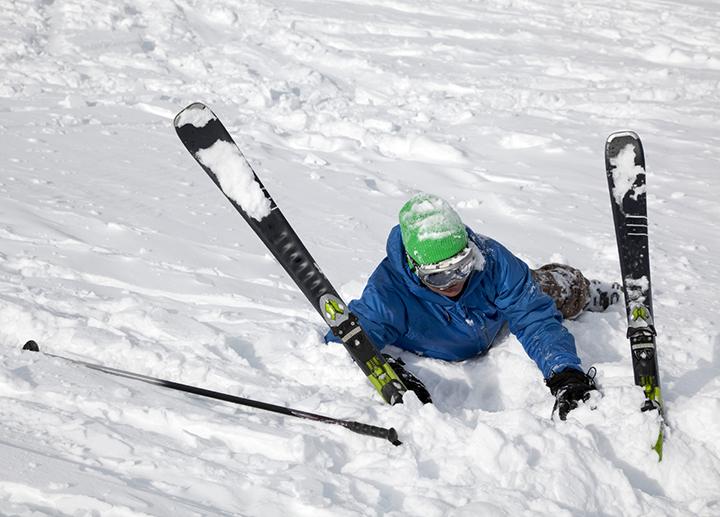The Timorous May Stay at Home
Think twice before suing the ski hill.
In 1929, the New York Court of Appeals issued an opinion rejecting a personal injury claim brought by a plaintiff injured in a fall on “the Flopper,” a Coney Island amusement park attraction in which participants tried to keep their balance while standing on a moving belt. In the opinion, eventual U.S. Supreme Court Justice Benjamin Cardozo wrote, “A fall was foreseen as one of the risks of the adventure. There would have been no point to the whole thing, no adventure about it, if the risk had not been there.” Cardozo famously added, “The timorous may stay at home.”
Cardozo’s red-blooded formulation of adventure versus timorousness should strike a chord with all but the most pantywaisted of fraidy-cat mollycoddlers. For the most part, the basic legal principle underlying Cardozo’s opinion still holds sway whenever participants in obviously risky activities file lawsuits after hurting themselves.
As anyone reading this magazine should know, the Bozeman area is riddled with opportunities to participate in injury-inducing activities. Foremost among these is skiing (and its trailer-trash cousin, snowboarding). The risk of injury from zooming down a mountainside at high velocity is ubiquitous, and reasonable skiers wear their garden-variety contusions and broken digits with pride. If nothing else, broken bones are helpful in establishing a skier’s non-timorousness.
Nevertheless, the eminently foreseeable possibility of serious injury while skiing creates a significant problem for anyone operating a ski area. Not only do ski operators prepare the very runs on which skiers must put their skills to the test, those same operators provide the lifts and tows that put skiers in harm’s way. All while raiding skiers’ wallets.
Close to 30 states, including Montana, have enacted legislation directed at preventing ski areas from being overwhelmed by lawsuits. The first such legislation came out of Michigan in 1962. (Who knew Michigan even had skiing? In fact, Michigan has around 40 ski areas, despite the fact that the 1,400-foot elevation gain in the entire state is little over half of the elevation gain at Bridger Bowl. Even Rhode Island, whose highest point is barely 800 feet above sea level, has a downhill ski area. People are apparently so desperate to ski that they’ll install a chairlift whenever they come across a snow-covered incline.)
The impetus in most states for enacting skier liability statutes came from a 1978 Vermont case in which a ski resort was ordered to pay $1.5 million to a 20-year-old skier who had been rendered quadriplegic in a fall after his skis became entangled in a bush concealed by snow. Montana’s Skier Responsibility Act, passed in 1979, stated, “A skier assumes the risk and all legal responsibility for injury to himself or loss of property that results from participating in the sport of skiing by virtue of his participation.”
This statutory language solved the problem of skiers filing frivolous lawsuits against ski resorts. But the statute basically prohibited any non-frivolous lawsuits as well. A ski resort probably shouldn’t be held liable when an out-of-control skier runs into a tree. But a different result may be appropriate where, for example, a resort runs over its customers with its snow-grooming equipment.
In a 1988 decision, the Montana Supreme Court held that key portions of the 1979 statute violated the constitutional guarantee of equal protection. So, the Montana legislature overhauled the Skier Responsibility Act in 1989 to the effect that skiers would only assume responsibility for injuries resulting from the “risks inherent in the sport of skiing,” such as variations in skiing terrain, bare spots, forest growth, and avalanches, “except on open, designated ski trails.”
In order to stay fresh, the Act was recently updated again by the 2007 legislature. The Act now includes lots of hip lingo, like a definition of “freestyle terrain” that includes “jumps, rails, fun boxes, half-pipes, quarter-pipes, and freestyle bump terrain.” Plus, the legal definition of “skiing” now includes using a snowboard “or any other sliding device.”
The 2007 legislature also expanded the list of inherent dangers and risks for which skiers would bear all legal responsibility. Specifically added to the list are “collisions with other skiers” and collisions with pretty much anything natural or manmade that wouldn’t be out of place at a ski area. On their face, these provisions are substantially similar to language in the original 1979 Act that was held to be unconstitutional: “[T]he responsibility for collisions with a person or object while skiing is the responsibility of the person or persons and not the responsibility of the ski area operator.”
To a large degree, the legislature’s circular battles with the Supreme Court over the extent to which ski resorts can be immunized from lawsuits is a moot point. Even if the Skier Responsibility Act were stricken from the books, an injured skier would still have to convince a jury that his or her injury was somebody else’s fault. This is always going to be a tough sell because, as Justice Cardozo observed, “There would have been no point to the whole thing, no adventure about it, if the risk had not been there.”
Alex Roots is an attorney with Landoe, Brown, Planalp and Reida, PC in Bozeman. To date, he remains a terrible skier.






